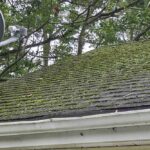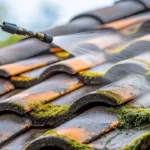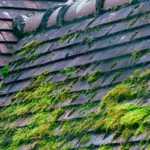When it comes to maintaining a healthy home environment, understanding the relationship between roof moss and rainwater collection safety is crucial. Many homeowners are unaware of the potential risks that moss growth on the roof can pose, especially when they rely on rainwater collection systems for household use. In this article, we’ll delve into the implications of roof moss on rainwater safety, how to manage it, and ensure that your rainwater collection practices are safe and effective.

What is Roof Moss?
Moss is a small, green plant that thrives in damp and shaded environments. It commonly appears on roofs, especially in areas where moisture accumulates and there is limited sunlight. While moss can give a house a rustic charm, it can also cause significant damage if left unchecked. The growth of moss can lead to the degradation of roofing materials, potentially impacting the safety and quality of collected rainwater.
Why is Roof Moss a Concern?
Damage to Roofing Materials
Moss retains moisture against the roof surface, which can lead to the deterioration of shingles and other roofing materials. This damage can create cracks and holes, allowing contaminants to enter your rainwater collection system.
Impact on Rainwater Quality
When moss and debris from the roof enter the rainwater collection system, they can contaminate the water with organic material and microorganisms. This can pose health risks if the water is used for drinking or cooking without proper filtration and treatment.
Ensuring Rainwater Collection Safety
Regular Roof Maintenance
To maintain roof safety and ensure the quality of your rainwater, regular maintenance is essential. Remove moss and debris from your roof and gutters to prevent contamination.
Install a First Flush Diverter
A first flush diverter can be installed in your rainwater collection system to ensure that the first flow of rain, which may contain the highest level of contaminants, is diverted away from your storage tanks.
Use Proper Filtration Systems
Investing in a high-quality filtration system is crucial for ensuring the safety of collected rainwater. Filters can remove sediments, organic materials, and microorganisms that could pose health risks.
How to Remove Roof Moss Safely
Removing moss from your roof should be done carefully to avoid damaging the roofing materials. It’s advisable to consult a professional for moss removal, but if you choose to do it yourself, make sure to use gentle techniques and appropriate cleaning solutions.
Preventing Moss Growth
Improve Roof Ventilation and Sunlight
Increasing the amount of sunlight and airflow your roof receives can help prevent moss from growing. Trim overhanging branches and ensure that your attic is properly ventilated.
Use Chemical Treatments
There are chemical treatments available that can prevent moss growth. These should be used with caution and according to manufacturer instructions to avoid harming the environment.
Benefits of Maintaining Roof and Rainwater Collection Systems
By keeping your roof and rainwater collection system in top condition, you can enjoy numerous benefits, including increased roof longevity, higher quality water for household use, and reduced health risks associated with contaminated water.
FAQs
Does moss on my roof mean it needs replacing?
Not necessarily. While moss can damage roofing materials over time, regular maintenance and removal can prevent the need for premature replacement. For more information, visit Bill Ragan Roofing.
What are the signs that my rainwater collection system is contaminated?
Signs of contamination include unusual odors, discoloration, or particles in the water. Regularly inspecting your system and maintaining filters can help prevent contamination.
How often should I clean my roof and gutters?
It is recommended to clean your roof and gutters at least twice a year, or more frequently if you live in an area with heavy rainfall or significant moss growth.

Conclusion
Understanding the relationship between roof moss and rainwater collection safety is essential for homeowners. By taking proactive measures to manage moss growth and maintain your rainwater collection system, you can ensure the safety and quality of the water you collect for household use. Regular maintenance, proper filtration, and awareness of potential risks are key to keeping your home safe and sustainable.
This article contains affiliate links. We may earn a commission at no extra cost to you.








